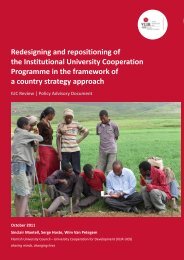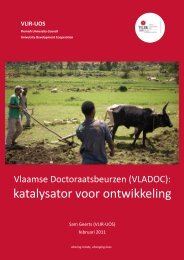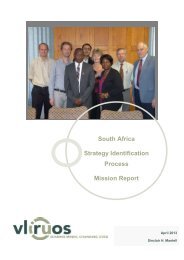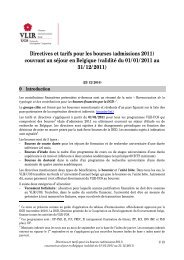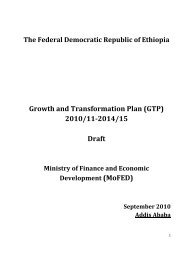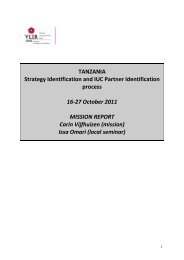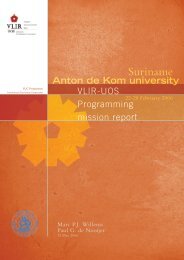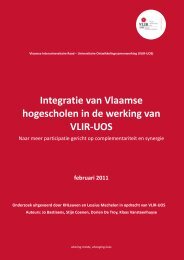Education Sector Development Program - VLIR-UOS
Education Sector Development Program - VLIR-UOS
Education Sector Development Program - VLIR-UOS
You also want an ePaper? Increase the reach of your titles
YUMPU automatically turns print PDFs into web optimized ePapers that Google loves.
<strong>Education</strong> <strong>Sector</strong> <strong>Development</strong> <strong>Program</strong> IV<br />
and to fund certain of its components. Given the<br />
longstanding engagement of most development<br />
partners to the improvement of education in<br />
Ethiopia, it can be expected that such positive<br />
collaboration will continue in the medium term.<br />
6. Full implementation of BPR<br />
Under ESDP III, public administration in Ethiopia<br />
has engaged in an ambitious reform to restructure<br />
its organization conducted under the business<br />
process reengineering paradigm. At all levels<br />
of the administration, departments operating by<br />
sub-sectors were abolished in favor of a process<br />
oriented structures. The reform still requests full<br />
implementation so that it can reach its intended<br />
effects of increased effectiveness and efficiency.<br />
Policy makers have been fully committed so far<br />
to its implementation and this can be expected<br />
to continue.<br />
Risks and mitigation<br />
While the above are assumptions that form broad<br />
underlying conditions for a successful ESDP IV<br />
implementation, there are also some risks which<br />
are inherent to the education sector.<br />
1. Turn-over of qualified staff (both<br />
teaching and administrative)<br />
Under ESDP III many capacity development<br />
activities were conducted throughout the<br />
education sector, but both teaching and<br />
administrative staff continue to experience a<br />
high level of turnover. ESDP IV is equally geared<br />
to capacity development, but it also foresees<br />
activities related to career progression and<br />
career development which should enhance<br />
the motivation of staff to remain within present<br />
functions, and thus help to reduce staff turnover.<br />
2. Community support slowing down<br />
The level of community support to education<br />
has been significant under ESDP III in particular<br />
with regard to the construction of schools in<br />
rural areas. The motivation of the community<br />
to support education is very high because<br />
parents perceive education as a prospect for<br />
social mobility and a substantial opportunity<br />
to improve life chances of their children. There<br />
may be a risk that education is not able to<br />
fulfill promises because the labor market may<br />
not be in a position to absorb flows of qualified<br />
graduates from education. As a consequence,<br />
community support may slow down out of a<br />
sentiment of disillusion. The drive to improve<br />
quality during this five year plan is designed to<br />
keep communities supportive of keeping their<br />
children in school. Understanding labour market<br />
demand for more educated employees will also<br />
be key to a more nuanced approach.<br />
3. Lack of sustainability of reliance on<br />
the private sector, especially for the<br />
development of TVET<br />
The current involvement of the private sector in<br />
organizing and delivering TVET programs is very<br />
high since more than 50% of TVET students are<br />
enrolled in the private sector. Given that parents<br />
have to pay tuition fees, this is an expression of<br />
the strong interest of families to offer education<br />
to their children beyond secondary education,<br />
but also of the capacity of the private sector to<br />
take on this task. The sustainability of a privately<br />
organized TVET may be questioned since it<br />
depends on the capacity of families to contribute<br />
which itself is a function of their income. In case of<br />
economic downturn, the private offer may shrink<br />
and training opportunities could disappear. A<br />
clear link between technical vocational education<br />
and work opportunities will again be important to<br />
reducing this risk.<br />
4. Emergencies : drought and natural<br />
catastrophes<br />
Over the past years, Ethiopia experienced several<br />
periods of drought which have severely affected<br />
certain regions with regard to food security.<br />
Emergencies such as caused through natural<br />
catastrophes affect all parts of human life,<br />
including education. Populations may need to be<br />
on the move. Children may not be in a position<br />
to go to school. Funding may be distracted from<br />
education for emergency interventions and food.<br />
ESDP IV has foreseen a cross-cutting program on<br />
education in emergencies as a means to be able<br />
to quickly respond to the circumstances arising<br />
out of emergency.<br />
5. Funding gap<br />
Implementation of the plan depends on filling a<br />
funding gap of about 30 billion birr over the life<br />
of the program Failure to fill this funding gap will<br />
mean that elements of the education program<br />
will not be implemented. Increased government<br />
financing (though the share of education in the<br />
budget is already high), continued and growing<br />
donor support and community contributions<br />
can help fill this gap, while a more effective use<br />
of available resources will also lead to greater<br />
results.<br />
107




